OUTPUT CHARACTERISTICS:
Figure shows a "Common Emitter" amplifier stage.

Common Emitter Amplifier Stage
With no base/emitter bias applied, there will be no collector current flowing. The output voltage VCE will be equal to the supply voltage (40V). As the collector current IC flows through resistor RL there will be a voltage drop (IC x RL) across the resistor. The collector voltage will depend upon the collector current i.e. 40V minus IC x RL volts.
If IC is zero, then VCE must be 40v. VCE could be reduced to zero by a value of IC of 40/RL amperes. If we assume RL to have a value of 18 ohms, then VCE will be zero for an IC of approximately 2.2 amperes.
Figure shows a graph plotting collector current against collector/emitter voltage
for different values of base current.
The straight line from the collector/emitter voltage axis to the collector current axis is the "Load Line" and indicates the only values of VCE and IC which are possible for that circuit. Obviously, if a different value of RL is used, we would get a different load line with a different slope.

For amplifiaction to take place we must first apply an initial bias voltage to the base. With 1.3 VBE applied the IB will be 25mA giving an IC of 1.4A which would produce an output of 15V (VCE). If we now apply a sinusoidal input signal of 0.6V, the base current would vary between 15 --35mA, which in turn would vary the IC between 1.1 - 1.7A, giving a voltage output between 10 - 20V.
This produces an amplifier gain of 0.6A/25mA = 30. Figure shows the voltage/current waveforms of these variations.